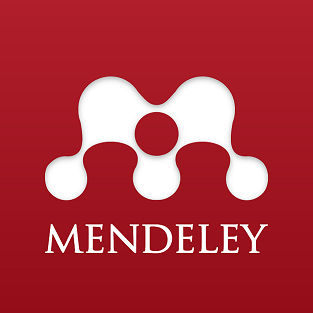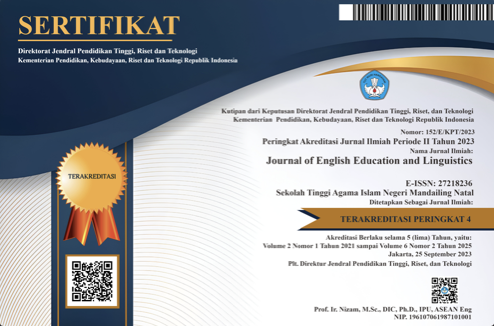TALKING STICK LEARNING MODEL: A STRATEGY IN ENHANCING STUDENTS’ ENGLISH PROFICENCY
DOI:
https://doi.org/10.56874/jeel.v1i1.82Keywords:
Talking Stick Learning Model, English Subject, Special Needed ProgramAbstract
This study aimed to know the level of students’ improvement through talking stick learning model in University of Muhammadiyah Lampung. This study composed of twenty students as the subject of this study and is anchored in Classroom Action Research (CAR). The data was collected through the pre-test and post-test and was analyzed using the average score. The result of this study revealed that Talking Learning Model can enhance the English proficiency of the students under the special needed program, University of Muhammadiyah Lampung.
References
Folse, K.S.(2019). Keys to Teaching Grammar to English Languag. Washington : The university of miehigan press
Imas Kurniasih, Berlin Sani.(2016).Ragam Pengembangan Model Pembelajaran untuk Peningkatan Profesionalitas Guru. Jakarta :Kata Pena
Suprijono, Agus.(2014). Cooperative Learning, Teori dan Aplikasi Paikem. Cet VI. Yogyakarta: Pustaka Pelajar.
Tomal, Daniel R.(2003). Action Research for Educators. United States of Amarerica: Scarecrow Press Inc.
Hanifah Widhia Ningrum, Budi Handoyo, Wiyaka.(2018). Meningkatkan Penguasan Grammar dalam Materi Future Tense dengan Mengunakan Cards of the Future Game Pada Siswa Kelas X SMAN 1 Semarang Tahun Ajaran 2018/2019. Media Penelitian Pendidikan. Vol.12. No. 2 Desember. Hal 152-156
Ika Safitri, Misykat Malik Ibrahim, Nursalam. (2018). Pengaruh Penerapan Model Talking Stick dengan Bantuan Media Choose Number terhadap Hasil Belajar Biologi di SMP Negeri 3 Sungguminasa Kabupaten Gowa. Vol. 6 . No. 1 Juni . Hal 131-144.
Maziya Dista. (2015). Penerapan Media Pembelajaran Talking Stick untuk Meningkatkan Keaktifan dan Hasil Belajar Siswa Mata Pelajaran TIK Siswa Kelas VII SMP Negeri 1 Kandeman. UNNES: Unpublished.
Nelvi Handayani, Amri Isyani, Fitrawati.(2013). Teaching-Learning Process: Simple Tense and Simple Future and Their Perception. Journal of English Language Teaching. Vol. . No. 2 March.hal 291-300.
Downloads
Published
Issue
Section
License
All articles published in the Journal of English Education and Linguistics are licensed under a Creative Commons Attribution-ShareAlike 4.0 International (CC BY-SA) license. This means anyone is free to copy, transform, or redistribute articles for any lawful purpose in any medium, provided they give appropriate attribution to the original author(s) and Journal of English Education and Linguistics, link to the license, indicate if changes were made, and redistribute any derivative work under the same license.
Copyright on articles is retained by the respective author(s) without restrictions. A non-exclusive license is granted to the Journal of English Education and Linguistics to publish the article and identify itself as its original publisher, along with the commercial right to include the article in a hardcopy issue for sale to libraries and individuals.
Although the conditions of the Creative Commons Attribution-ShareAlike 4.0 International (CC BY-SA) license do not apply to authors (as the copyright holder of your article, you have no restrictions on your rights), by submitting to the Journal of English Education and Linguistics, authors recognize the rights of readers and must grant any third party the right to use their articles to the extent provided by the license.

This work is licensed under a Creative Commons Attribution-ShareAlike 4.0 International License.








